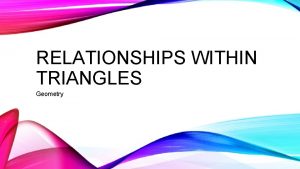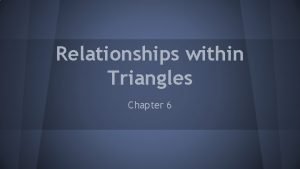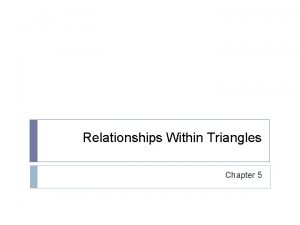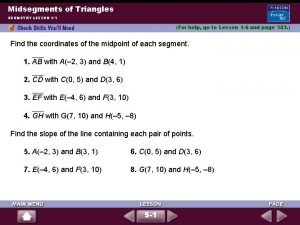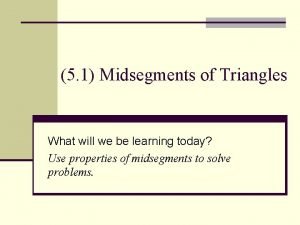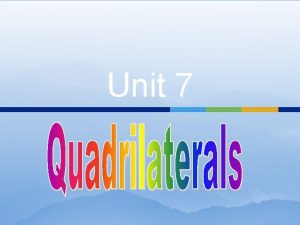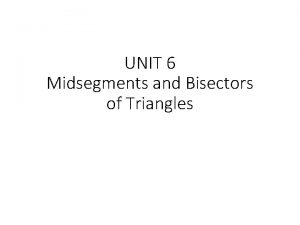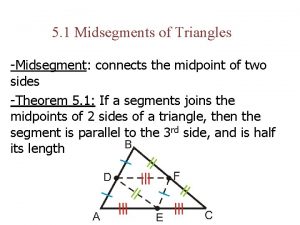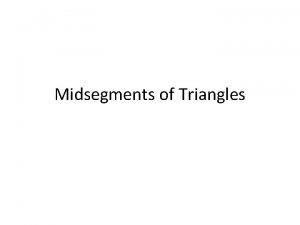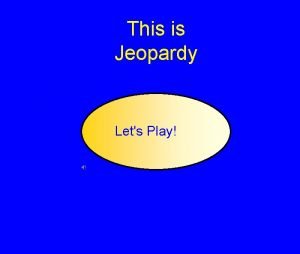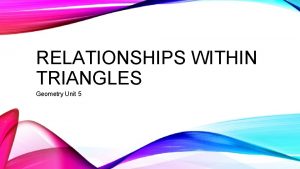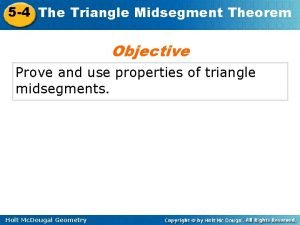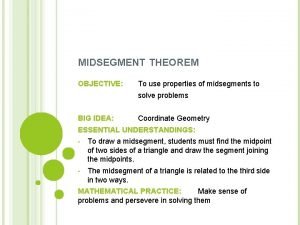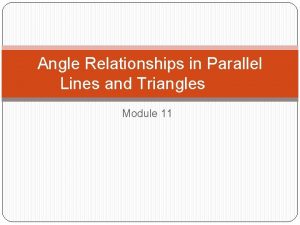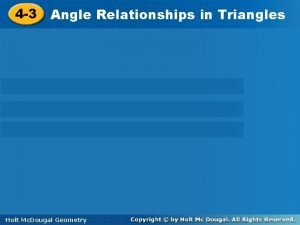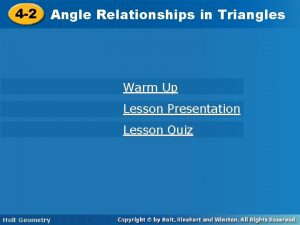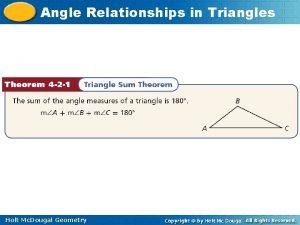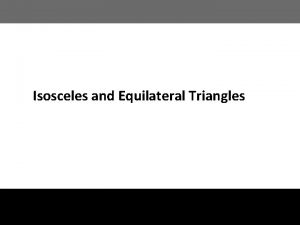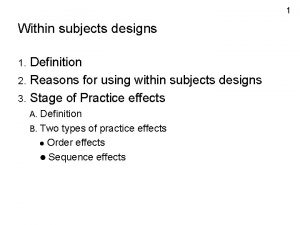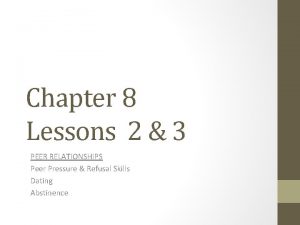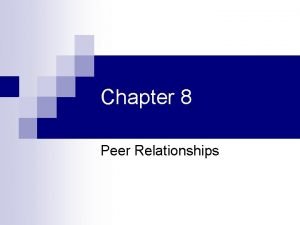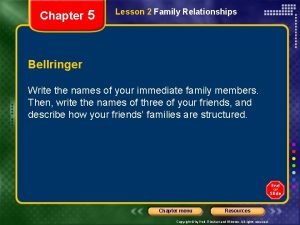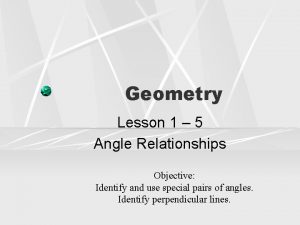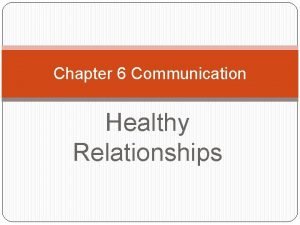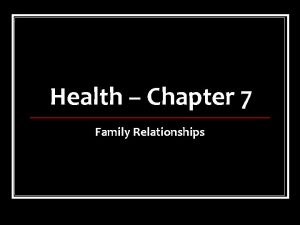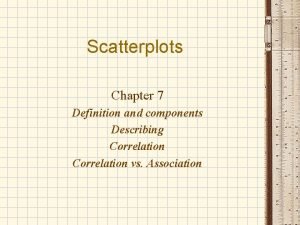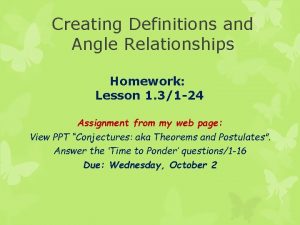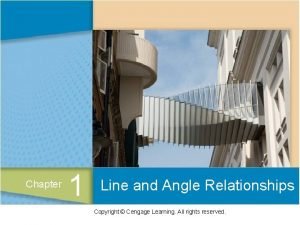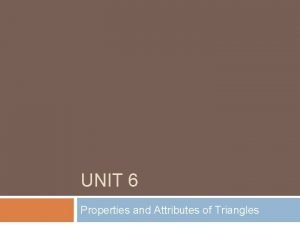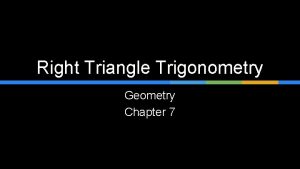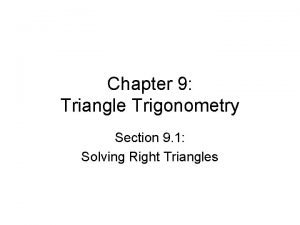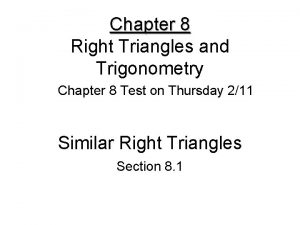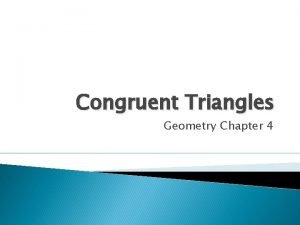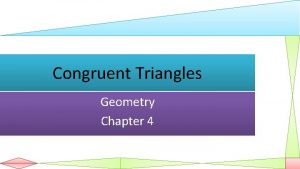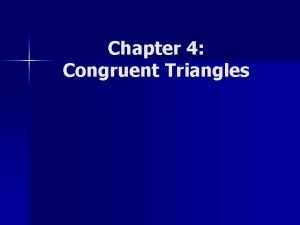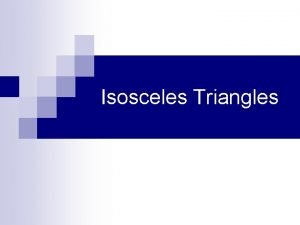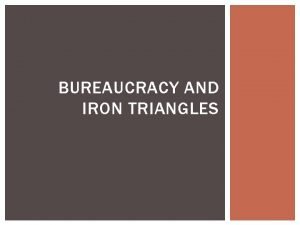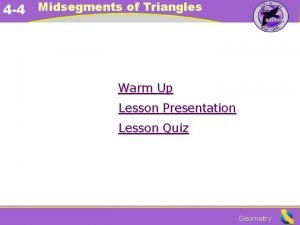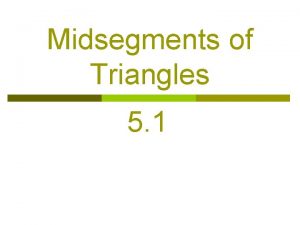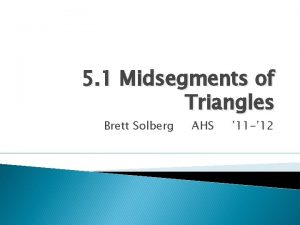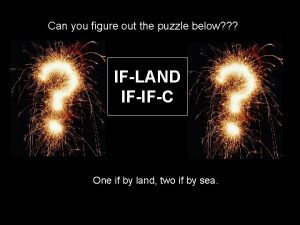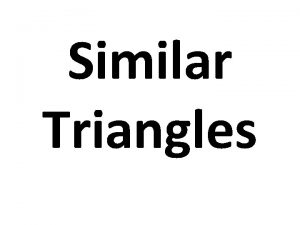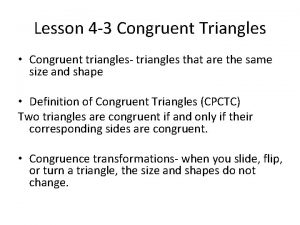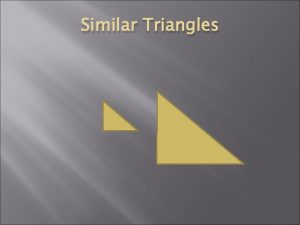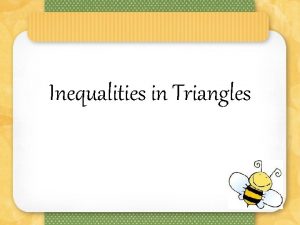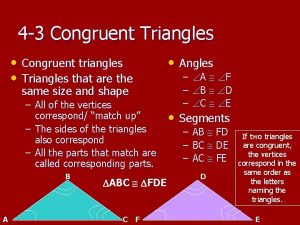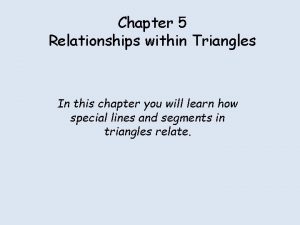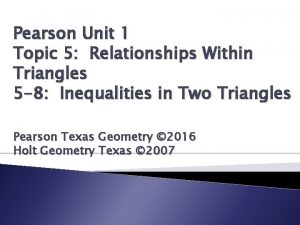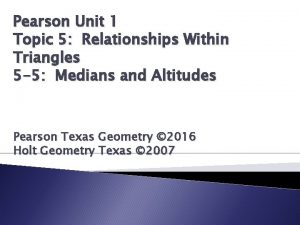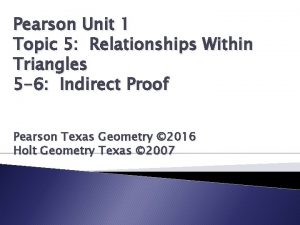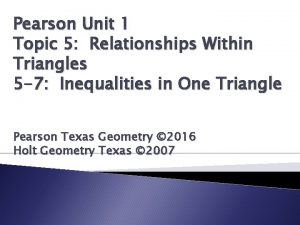Chapter 5 Relationships within Triangles Midsegments Definition of

















































- Slides: 49

Chapter 5 Relationships within Triangles


Midsegments • Definition of a midsegment: a segment connecting the _________ of two sides of the triangle. • Triangle Midsegment Theorem: if a segment joins the midpoints of a triangle, then the segment is _______ to the third side and is ______ as long.

Identifying Parallel Segments •

Using Properties of Midsegments • In the figure below, AD = 6 and DE = 7. 5. What are the lengths of: • DC = • AC = • EF = • AB =

Using Coordinate Geometry - Midsegments • The coordinates of the vertices of a triangle are E(1, 2), F(5, 6), and G(3, -2). • Find the coordinates of H, the midpoint of EG, and J, the midpoint of FG. • Show that HJ EF • Show that HJ = ½ EF.

Practice: pp. 289 – 290 #26, 38 -42 Challenge: p. 291 #48


Perpendicular Bisectors • Perpendicular Bisector Theorem: If a point is on the perpendicular bisector of a segment, then it is ___________ from the __________ of the segment. • Converse of the Perpendicular Bisector Theorem: If a point is _________ from the endpoints of a segment, then it is on the ____________ of the segment. • If PM is the perpendicular bisector of AB, then _____.

Using the Perpendicular Bisector Theorem • Find the length of QR.

Angle Bisectors • Angle Bisector Theorem: If a point is on the bisector of an angle, then the point is _________ from the sides of the angle. • Converse of the Angle Bisector Theorem: If a point in the interior of an angle is equidistant from the sides of the angle, then the point is on the _________. • If QS is the angle bisector of PQR, then _____.

Using the Angle Bisector Theorem • What is the length of FB?

Practice: pp. 296 -297 #9 -11, 16, 17, 32, 33


Definitions • Concurrent: Three or more lines that ___________________________ • Point of Concurrency: The point at which three lines _______ • In the diagram, the three lines are __________ and ____ is the point of concurrency. A

Concurrency of Perpendicular Bisectors Theorem • The perpendicular bisectors of the sides of a triangle are _________ at a point equidistant from the _______. • P is the ___________ of the triangle. It is the center of the circle that is circumscribed about the triangle • In ∆ABC, _____

Location of the Circumcenter • Draw in the perpendicular bisectors of each triangle to find the location of the circumcenter for each type of triangle. Acute Triangle Right Triangle Obtuse Triangle

Using Coordinate Geometry – Perpendicular Bisectors • What are the coordinates of the circumcenter of the triangle with vertices P(0, 6), O(0, 0), and S(4, 0)?

Concurrency of Angle Bisectors Theorem • The angle bisectors of a triangle are _________ at a point equidistant from the ______________. • P is the _________ of the triangle. It is the center of the circle that is inscribed in the triangle. • In ∆ABC, _____

Identifying and Using the Incenter • QN = 5 x + 36 and QM = 2 x + 51. What is QO?

Practice: pp. 305 -306 # 11, 14, 16, 18


Medians • A median of a triangle is a segment whose endpoints are a ________ and the __________ of the opposite side.

Concurrency of Medians Theorem •

Finding the Length of a Median • In ∆XYZ, ZA = 9. • What is the length of CA? • What is the length of ZC?

Altitudes • An altitude of a triangle is the _________ segment from a ________ of the triangle to the line containing the ___________.

Concurrency of Altitudes Theorem • The lines that contain the altitudes of a triangle are concurrent. • H is the ________ of the triangle.

Location of the orthocenter • Draw in the altitudes of each triangle to find the location of the orthocenter for each type of triangle. Acute Triangle Right Triangle Obtuse Triangle

Using Coordinate Geometry - Altitudes • ∆DEF has vertices D(1, 2), E(1, 6), and F(4, 2). What are the coordinates of the orthocenter of ∆DEF?

Identifying Medians and Altitudes • Determine whether each line is a median, altitude, or neither. • EG • AD • CF

Naming Medians and Altitudes • A median in ∆ABC • An altitude for ∆ABC • A median in ∆AHC • An altitude for ∆AHB • An altitude for ∆AHG

Summary of Triangle Segments • Name the type of segments that are concurrent at the given point.

Practice: pp. 312 -313 #8 -10, 15, 17 -20, 24 -27


Indirect Proof • A proof involving _______ reasoning is an indirect proof (sometimes called proof by ________). • Step 1: Temporarily assume the _______ of what you want to prove (negation). • Step 2: Show that this temporary assumption leads to a _________. • Step 3: Conclude that the temporary assumption must be ______ and that what you want to prove must be true.

Writing an Indirect Proof • Given: ∆ABC is scalene (all sides have different lengths) • Prove: A, B, and C all have different measures • Step 1: Assume temporarily the opposite of what you want to prove. • Step 2: Show that this assumption leads to a contradiction • Step 3: Conclude that the temporary assumption must be false and that what you want o prove must be true.

Writing an Indirect Proof •

Writing an Indirect Proof • Given: ∆LMN • Prove: ∆LMN has at most one right angle

Practice: pp. 320 -322 #17, 23, 24, 29


Theorems • Theorem 5 -10: If two sides of a triangle are not congruent, then the _______ angle lies opposite the ______ side. • Theorem 5 -11: If two angles of a triangle are not congruent, then the ______ side lies opposite the ______ angle. • Triangle Inequality Theorem: The sum of the lengths of any two sides of a triangle is ___________ the length of the third side.

Using Theorem 5 -10 and 5 -11 • In ∆SOX, OX = 4, OS = 6, and XS = 9. Order the angles from least to greatest. • In ∆SOX, m S = 24 and m O = 130. Which side of ∆SOX is the shortest side?

Using the Triangle Inequality Theorem • Can a triangle have sides with lengths 2 m, 6 m, and 9 m? Explain. • A triangle has side lengths of 4 in. and 7 in. What is the range of possible lengths for the third side?

Practice: pp. 329 -330 #12, 19, 25, 26, 30, 31, 37 -39


The Hinge Theorem (SAS Inequality Theorem) • If two sides of one triangle are congruent to two sides of another triangle, and the included angles are not congruent, then the longer third side is opposite the larger included angle. BC ______ YZ • Converse of the Hinge Theorem (SSS Inequality): If two sides of one triangle are congruent to two sides of another triangle, and the third sides are not congruent, then the larger included angle is opposite the longer third side. A ______ X

Using the Hinge Theorem • What inequality relates LN and OQ in the figure below.

Using the Converse of the Hinge Theorem • What is the range of possible values for x in the figure below?

Practice: pp. 336 -337 #6 -9, 11 -14, 16 -18
 Relationships within triangles
Relationships within triangles Chapter 6 relationships within triangles answer key
Chapter 6 relationships within triangles answer key Relationships within triangles
Relationships within triangles Midsegments of triangles answers
Midsegments of triangles answers Midsegments of triangles quick check
Midsegments of triangles quick check Geometry unit 7 lesson 1
Geometry unit 7 lesson 1 Midsegments of triangles quick check
Midsegments of triangles quick check 5-1 midsegments of triangles
5-1 midsegments of triangles What is a midsegment
What is a midsegment And are midsegments of δwxy.
And are midsegments of δwxy. Geometry unit 5 relationships in triangles
Geometry unit 5 relationships in triangles Every triangle has __________ midsegments.
Every triangle has __________ midsegments. Midsegment of a triangle
Midsegment of a triangle Module 11 angle relationships in parallel
Module 11 angle relationships in parallel 4-3 angle relationships in triangles worksheet answers
4-3 angle relationships in triangles worksheet answers 4-2 angle relationships in triangles answers
4-2 angle relationships in triangles answers Triangle angle relationships
Triangle angle relationships Isosceles triangle algebra
Isosceles triangle algebra Within subject design definition
Within subject design definition Chapter 7 family relationships
Chapter 7 family relationships Chapter 8 lesson 1 safe and healthy friendships
Chapter 8 lesson 1 safe and healthy friendships Chapter 7 family relationships
Chapter 7 family relationships Section 1 organisms and their relationships
Section 1 organisms and their relationships Principles of ecology chapter 2 section 1 answer key
Principles of ecology chapter 2 section 1 answer key Chapter 2 principles of ecology answers
Chapter 2 principles of ecology answers Chapter 2 principles of ecology answer key
Chapter 2 principles of ecology answer key Chapter 8 lesson 1 safe and healthy friendships
Chapter 8 lesson 1 safe and healthy friendships Chapter 6 skills for healthy relationships
Chapter 6 skills for healthy relationships Chapter 7 lesson 1 healthy family relationships answer key
Chapter 7 lesson 1 healthy family relationships answer key Chapter 18 healthy family and peer relationships
Chapter 18 healthy family and peer relationships Name the angle pair.
Name the angle pair. Chapter 7 lesson 1 healthy family relationships
Chapter 7 lesson 1 healthy family relationships Chapter 6 communication and relationships
Chapter 6 communication and relationships Chapter 7 family relationships
Chapter 7 family relationships Scatterplots definition
Scatterplots definition Define the relationship ch 6
Define the relationship ch 6 Chapter 6 building healthy peer relationships
Chapter 6 building healthy peer relationships Chapter 2 section 1 organisms and their relationships
Chapter 2 section 1 organisms and their relationships What is social relationship
What is social relationship Applying angle relationships homework 2 answer key
Applying angle relationships homework 2 answer key How to use an angle chapter 1
How to use an angle chapter 1 Identify m∠efh.
Identify m∠efh. Chapter 7 right triangles and trigonometry answer key
Chapter 7 right triangles and trigonometry answer key Chapter 9 right triangles and trigonometry
Chapter 9 right triangles and trigonometry Magic triangle trigonometry
Magic triangle trigonometry Chapter 4 test triangle congruence answers
Chapter 4 test triangle congruence answers Chapter 4 congruent triangles
Chapter 4 congruent triangles 4-1 practice congruent figures
4-1 practice congruent figures Definition of isosceles triangle theorem
Definition of isosceles triangle theorem Iron triangles definition
Iron triangles definition
